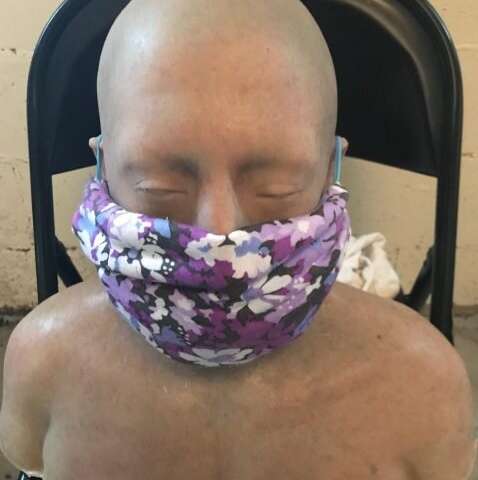Due to the unknown numbers of asymptomatic people infected with the SARS-CoV-2, the Centers for Disease Control and Prevention has recommended that all citizens wear face coverings when in public. More recently, some states have mandated face coverings. Many people are wearing homemade coverings, but these mandates potentially increase demand for medical face masks, exacerbating shortages for first responders and medical staff.
One way to to extend the supply of disposable masks is to disinfect them and reuse them. We have just published a paper in the Journal of the International Society for Respiratory Protection that looks into whether disposable masks can be disinfected by heating them without compromising their effectiveness. We also compared the effectiveness of medical-grade masks with homemade ones, and looked into the feasibility of improving masks with homemade nose clips.
Prior work by others on disinfection of disposable masks has shown that heating for 30 minutes at 158 degrees F (70 C) or above can effectively destroy SARS, influenza and the novel SARS-CoV-2 coronavirus. This can be done in a home oven. As such, we did no testing with viruses. Instead we focused on whether repeated heat disinfection affected how well the masks worked for removing particles in the same size range as coronavirus.
To do this, we put masks onto mannequin heads, and rigged the heads to “breathe” through their noses and mouths, using a vacuum pump. We then exposed the mannequins to black carbon (i.e, soot) from a kerosene lamp, which generates particles that overlap in size with those of the coronavirus. We determined filtration efficiency by comparing black-carbon levels on both sides of the masks worn by the mannequins. We did this with two brands of disposable N95 respirators and one brand of disposable surgical mask, as well as with one design of homemade face covering. We tried this out repeatedly, and in a variety of ways.

First, to measure the maximum filtration efficiency and resilience of the disposable masks, each disposable mask type was tested while taped or modified to tightly fit a plastic mannequin’s face when new, and again after each heating cycle. We found that one N95 brand (3M) and a surgical mask (HSl brand) stood up to the 10 cycles of heat disinfection and reuse, with no reduction in performance. Filtration efficiency was greater than 95 percent over all 10 cycles for N95 respirators, and greater than 70 percent for surgical masks. (In contrast, we found that the nose-pad of another N95 brand, the Moldex, was unable to withstand multiple cycles of being put on and off the mannequin, whether or not it was heated in between uses.)
These tests show the maximum filtration efficiency possible, but they are not representative of how people normally wear masks, where the fit can be much looser. So, for a second set of tests, we obtained a head form covered in soft silicone to mimic the pliability of the human face. We then assessed the effectiveness of the masks as they are commonly worn, by simply putting the elastic straps around the head or ears without additional tightening. As expected, the filtration efficiency of all the disposable masks decreased substantially, to around 40 percent. This confirms that the effectiveness of such masks relies upon a tight fit, and this may be hard for many people to achieve.
We also tested the filtration efficiency of three homemade cloth coverings made following instructions on the CDC website. We made one from a cotton dress, one from a cotton sweater, and the third from polyester cloth. All three were worn in a normal mode on the silicone head form as directed by the CDC. The filtration efficiency of the cotton homemade cloth coverings in normal use was 55 percent, while the polyester covering came in at near 40 percent—about the same as loosely fitted medical-grade masks. This suggests that homemade cotton masks might actually work better than loosely fitted disposable masks, while polyester might be about the same.
We heated up the homemade masks for disinfection, which appeared to not affect the filtration efficiency. The CDC recommends washing and drying such coverings at home and we anticipate negligible effects on efficiency from this as well. When disinfecting your masks at home, we recommend you to place masks in an oven bag or a pressure cooker during heating, rather than directly put masks inside of the oven.
Finally, to see if we could improve the fit for the public, we designed a process that uses heat-moldable plastic strips to make homemade customized nose clips molded to an individual’s face. By adding the customized nose clip to a normally worn disposable mask on a silicone head form, the filtration efficiency of the 3M N95 returned to greater than 95 percent, and the filtration efficiency of the surgical masks was measured at 88 percent. The nose clips passed two five-hour wearing tests for comfort. But due to the use of heat moldable plastic, the customized nose clips cannot be disinfected with heat; rather, they must be disinfected by soaking in solutions of alcohol or bleach.
This work has certain limitations. For one, our tests were all done under static conditions at a constant flow rate of air similar to how an adult breathes when sitting. We did not take into account the increase in breathing, nor the reduction in fit that can occur when someone is talking or active.
Our study is just one of many looking into how masks may be disinfected and reused. Others have been carried out or are in progress using not only heat, but ultraviolet light, vaporized hydrogen peroxide, or soaking in ethyl alcohol or bleach solutions. Most of these are aimed at medical personnel using specialized equipment. The soaking methods have been shown to reduce the effectiveness of certain types of N95 masks. Ours is a relatively modest effort aimed at everyday usage. Far more work needs to be done, but everything we know so far suggests that wearing almost any kind of mask in public is better than nothing; that a tight fit is best; and that, with certain limits, many types of masks can be reused outside of medical settings.
Roland Yan, Steve Chillrud, Debra Magadini, and Beizhan Yan, Columbia University


